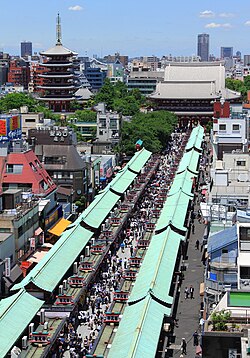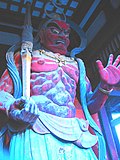Sensō-ji
Sensō-ji (Japanese: 金龍山浅草寺, Hepburn: Kinryū-zan Sensō-ji) is a very old Buddhist temple in Tokyo, Japan. It is in the neighbourhood of Asakusa and one of the oldest and most important temples in Tokyo. It was first created in 645 BCE. The most important deity for the temple is Kannon Bosatsu (also called Avalokiteśvara).
| {{{building_name}}} | |
|---|---|

| |
| Basic information | |
| Location | 2-3-1 Asakusa, Taitō-ku, Tokyo |
| Affiliation | Buddhist |
| Website | www |
| Architectural description | |
| Founder | Kaishō |
| Completed | 645 |
| Specifications | |
Many times in Japanese history, Sensō-ji had a very big role. For example, during the Edo shogunate, when Tokugawa Ieyasu was the leader of Japan, he made Sensō-ji the most important temple of the Tokugawa clan. Later on, some stores were opened in front of the temple. These stores are still in front of the temple right now.
The buildings on the land of the temple are not the original ones when the temple was first created. Many of the gates and art have been created again after their destruction.
History
Creation of the temple
A legend from the area says that in the 7th century, some fishermen found a gold statuette of Kannon. The statuette was caught in their fishing nets on the Sumida River.[1] Sensō-ji was built so that people could worship the statuette. The land that Sensō-ji is on used to have a very big Buddhist temple in the 8th century.[1]
During and after World War II
During World War II, Japan was fighting the United States. Because of this, many Japanese cities were hit by bombs coming from airplanes. During the Great Tokyo Air Raid in March 1945, Sensō-ji and other parts of Asakusa were destroyed. This included many buildings of the temple and some art.[2]
Parts of the temple
Kaminarimon
The Kaminarimon (雷門, "Thunder Gate") is one of the two big gates of Sensō-ji. People that go through the gate will get to the actual temple building and the Hōzōmon. The gate is 11.7 metres (38 ft) tall, 11.4 metres (37 ft) wide and has an area of 69.3 square metres (746 sq ft).[3] The gate has a big red lantern. It is usually replaced close to every 10 years.[4]
The gate that is in front of the temple right now is not the same one that used to be used. The first gate was created in 941 (during the Heian period) and was burned down in a fire in 1865.[5] After Konosuke Matsushita gave money for it to be built again, a new gate was built in 1960.[4]
Hōzōmon
The Hōzōmon (宝蔵門, "Treasure-House Gate") is the other big gate of Sensō-ji. It is closer to the temple than the Kaminarimon. The gate has two storeys (called a nijūmon in Japanese). Inside the gate, many important objects are kept there.
On the left and the right side of the gate, two very big sandals that are made of straw (called "ōwaraji", or "big waraji")[6] are hung. They are both 4.5 metres (15 ft) long, 1.5 metres (4.9 ft) wide, and have a weight of 500 kilograms (1,100 lb).[7] New sandals are made every 10 years by people from Tateokāramachi, a neighbourhood in Murayama, Yamagata. The eighth pair of sandals was made in 2018.[8] The ōwaraji are hung there to protect the temple from evil. They are supposed to show how powerful the statues of Nio in the Hōzōmon are.[9] The first ōwaraji were from 1941. The tradition comes from Toshizo Matsuoka, who was a part of the House of Representatives of Japan. He gave some straw sandals to the temple.[9]
Nakamise-dōri
The Nakamise-dōri (仲見世通り) is a street in front of the temple. Around the street are many small stores that sell souvenirs and food. The street is 250 metres (270 yd) long and has 89 shops.[10]
Gallery
Pagoda with five floors
Sensō-ji Media
One of the Niō statues that stand on either side of the gate's south face
References
- ↑ 1.0 1.1 Iwasaki, Toshio (1990). "Asakusa: A Glimpse Of Old Edo". Journal of Japanese Trade & Industry (2). https://www.jef.or.jp/journal/pdf/outing_9003.pdf. Retrieved 9 November 2020.
- ↑ Takeda, Kazuhiro (5 April 2020). "Sensoji to receive framed motto after original destroyed in World War II". The Asahi Shimbun. Archived from the original on 9 November 2020. Retrieved 8 November 2020.
- ↑ "雷門". 浅草の歴史と観光 (in 日本語). 10 April 2002. Archived from the original on 24 February 2008. Retrieved 8 November 2020.
- ↑ 4.0 4.1 Greuner, Tabea (21 April 2020). "Sensoji Temple's Kaminarimon gate gets a massive new red lantern". Time Out. Time Out Group. Retrieved 8 November 2020.
- ↑ "Famed Kaminarimon lantern gets rare makeover". The Japan Times. 18 November 2013. Archived from the original on 23 October 2022. Retrieved 8 November 2020.
- ↑ Gordenker, Alice (16 June 2005). "Owaraji". The Japan Times. Retrieved 8 November 2020.
- ↑ "宝蔵門". 浅草 (in 日本語). Retrieved 8 November 2020.
- ↑ "第8回浅草寺大わらじ奉納". Murayama City (in 日本語). 28 December 2018. Retrieved 8 November 2020.
- ↑ 9.0 9.1 "Giant Sandals Headed for Sensoji Temple". The Daily Yomiuri. 15 October 2018.
- ↑ "The History of Nakamise". Asakusa Nakamise. Retrieved 9 November 2020.
Other websites
- Lua error in Module:Official_website at line 90: attempt to index field 'wikibase' (a nil value). (in Japanese)












